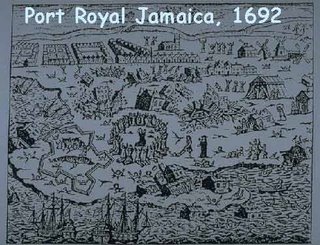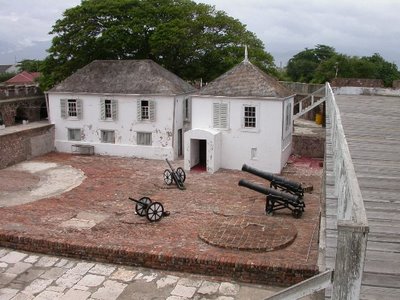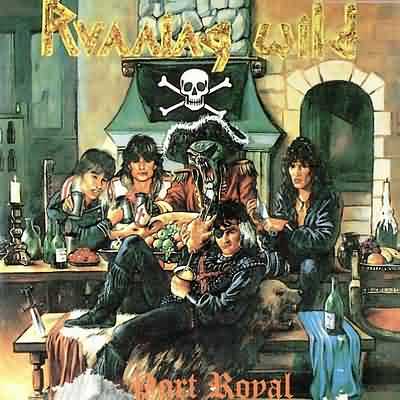
PORT ROYAL'S EARLY DAYS
In December 1654, Oliver Cromwell, Lord Protector of England, sent an invasion force under the commands of Admiral Penn and General Venables to capture Hispaniola. The Spanish were forewarned of the attack and soundly defeated the English forces attempting to capture the city of Santo Domingo. Failing miserably and fearing to return to England empty handed, Penn and Venables sailed south to Jamaica, and in May 1655, captured the poorly defended island with relatively little resistance. In short, Jamaica became a consolation prize to appease Cromwell.
Construction of Passage Fort, also known as Fort Cromwell, began in a matter of weeks following the conquest. Situated at the tip of the sand spit separating Kingston Harbor from the Caribbean, the fort could control all access to the harbor through the narrow entrance. A small community, known as The Point or Point Cagway, consisting of mariners, merchants, craftsmen, and prostitutes, built up around the fort (Pawson and Buisseret 1975:7). After the restoration of Charles II and the monarchy in England in 1660, The Point was renamed Port Royal, and the fort, was renamed Fort Charles (Taylor 1965:131; Pawson and Buisseret 1975:9).
Although Port Royal was designed to serve as a defensive fortification, guarding the entrance to the harbor, it assumed much greater importance. As a result of its location within a well-protected harbor, its flat topography, and deep water close to shore, large ships could easily be serviced, loaded, and unloaded. Ships' captains, merchants, and craftsmen established themselves in Port Royal to take advantage of of the trading and outfitting opportunities. As Jamaica's economy grew and changed between 1655 and 1692, Port Royal grew faster than any town founded by the English in the New World, and it became the most economically important English port in the Americas.

ON JUNE 7, 1692, after winding up his morning prayer service, Dr. Emmanuel Heath, the Anglican rector in Port Royal, left St. Paul's Church and walked to a nearby tavern. There he met his friend John White, who was president of the island's Council, and the two men got to chatting. Soon goblets of wormwood wine were brought out and White lit his customary pipe of tobacco. Before it was outed and the wine drunk, the floor suddenly began to rumble and shake. "Lord, Sir," the Rev. Heath asked his friend, "what's this?" (Gragg, 2000).
Following the earthquake, Port Royal underwent a dramatic revival only to fall again when it was ravaged by fire in 1703. A total of 16 hurricanes between 1712 and 1951 have consistently slashed Jamaica, as have an additional six earthquakes between 1770 and 1956 (Cox 1984:Appendix B). Following a severe storm, a hurricane, and two earthquakes in 1722, Port Royal as it once was disappeared for the last time.
PORT ROYAL TODAY
As one walks along the narrow streets of the poor fishing village of Port Royal today, it is hard to imagine that it once was the largest and most economically important English settlement in the Americas. It is now an isolated place at the end of a long sand spit. It has a population of ca. 1800 people, who view themselves as 'Port Royalists,' rather than as simply Jamaican.Considerable work has been conducted on the section of Port Royal that remains submerged below the water of Kingston Harbor (see Link 1960; Marx 1973; Hamilton 1984, 1985, 1986, 1988). For various reasons, these data have not been used by archaeologists working on contemporaneous 17th-century English colonial sites in North America. Much can be learned from Port Royal, for the underwater excavations have resulted in remarkable parallels and even more interesting contrasts with contemporaneous English colonists in North America.
Port Royal Plaza

For further information on the history of Port Royal, check the following links:
http://www.noquartergiven.net/jamaica.htm
http://nautarch.tamu.edu/portroyal/
http://nautarch.tamu.edu/portroyal/PRhist.htm
http://www.jamaicans.com



1 comment:
[url=http://bariossetos.net/][img]http://vonmertoes.net/img-add/euro2.jpg[/img][/url]
[b]student purchase software, [url=http://vonmertoes.net/]what is quarkxpress[/url]
[url=http://vonmertoes.net/][/url] discount adobe software buy cheap software discount
standard office software [url=http://vonmertoes.net/]www macromedia com software flash fl4about[/url] buy photoshop 7
[url=http://bariossetos.net/]2 Mac[/url] adobe acrobat software
[url=http://bariossetos.net/]software developers in canada[/url] oem software site
buy microsoft photoshop [url=http://vonmertoes.net/]kaspersky review[/b]
Post a Comment